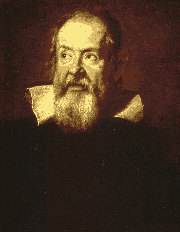|

Justus Sustermans, Portrait of Galileo
Galilei
Galleria degli Uffizi, Florence

Giuseppe Bezzuoli, Galileo performs the experiment on falling bodies.
Affresco, Tribuna di Galileo,
Museo Zoologico "La Specola"
|
Born in Pisa on 15th
February, 1564, he taught natural philosophy at the University of
Pisa. He then moved to the Studio at Padua, where he held the chair
of Mathematics until 1610. In the Paduan years he carried out studies
and experiments on mechanics, thought up the thermometer, and made
the geometric and military compass. In 1609 he put together the first
telescope, with which he made extraordinary discoveries in the heavens:
from the mountains on the Moon to the mass of stars making up the
Milky Way, from the phases of Venus to the four satellite moons of
Jupiter, which he entitled the Medicean Planets in honour of the ruling
house of Tuscany.
From 1612, opposition to Galileo's cosmological
theories was on the rise. He claimed, along with Copernicus, that
the Earth moved and that the Sun was the centre of the Universe. Particularly
fierce and threatening was the hostility from theologians to the heliocentric
theories put forward by Galileo. These conflicts lead to charges being
brought against Galileo in 1633 by the Tribune of the Inquisition.
The trial ended with the Pisan scientist's condemnation and abjuration.
The galileian contribution to pneumatics
was essentially on the determination of the working limits of the
suction pump, which he fixed at 18 braccia (about 11 metres).
Galileo noted that beyond that level, the raised column of water collapsed.
He attributed this limit to the force of the vacuum. The galileian
analysis provided the base from which many natural philosophers (especially
Berti, Magiotti, Magni and Torricelli) set off to make their discoveries
of atmospheric pressure and the real possibility of producing the
vacuum in nature. In this sense, even though Galileo was far away
from fully understanding the role of atmospheric pressure in pneumatic
phenomena, his theses provided an essential starting-point, both on
the strictly theoretical level and on that of methodology, for working
out the conceptual apparatus of the modern "science of the vacuum".
|

